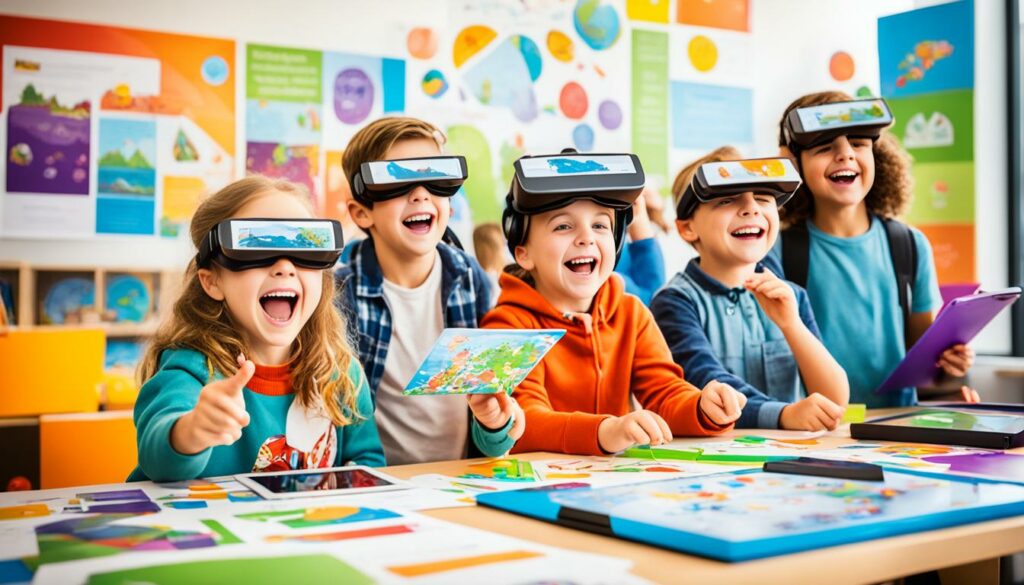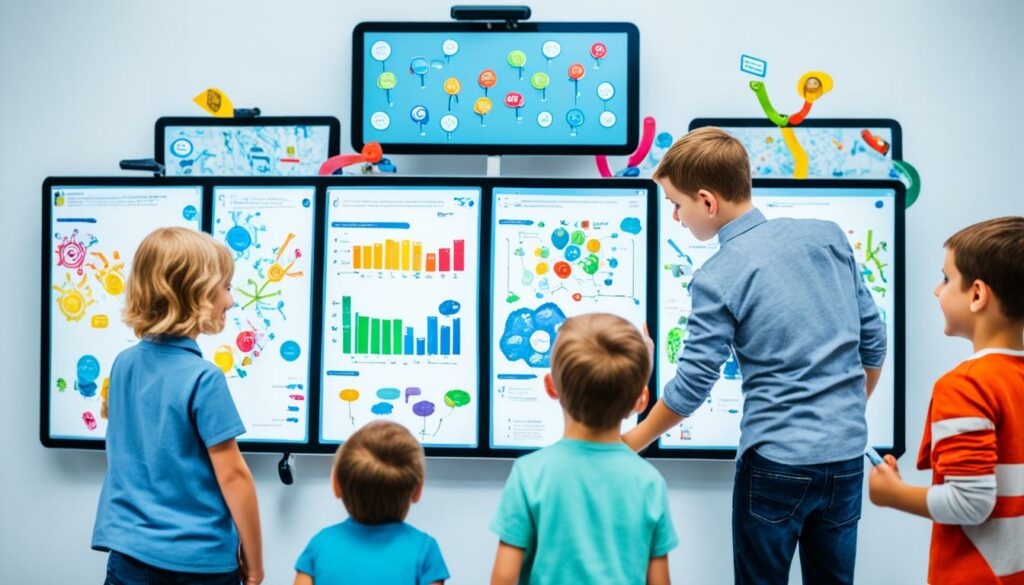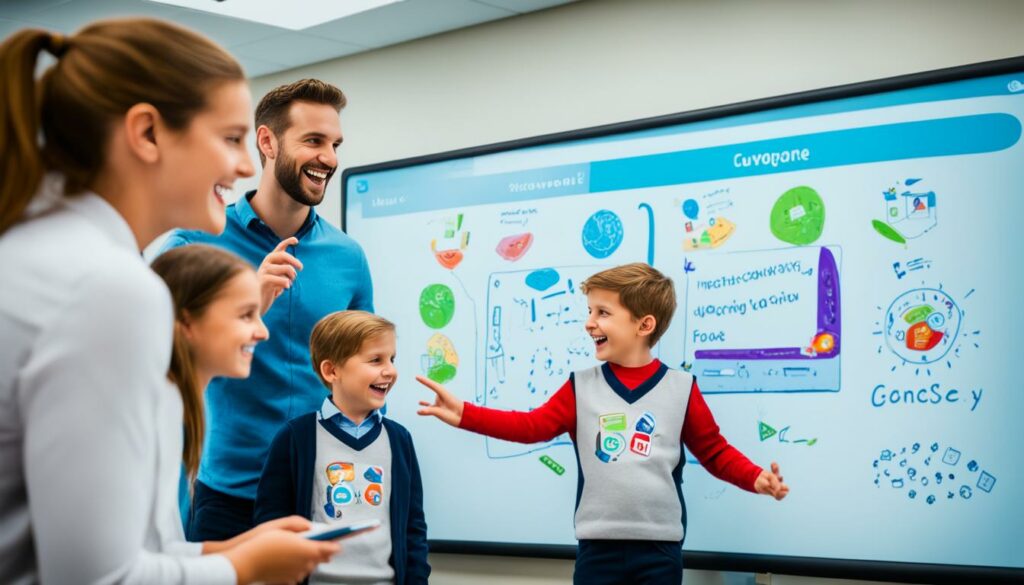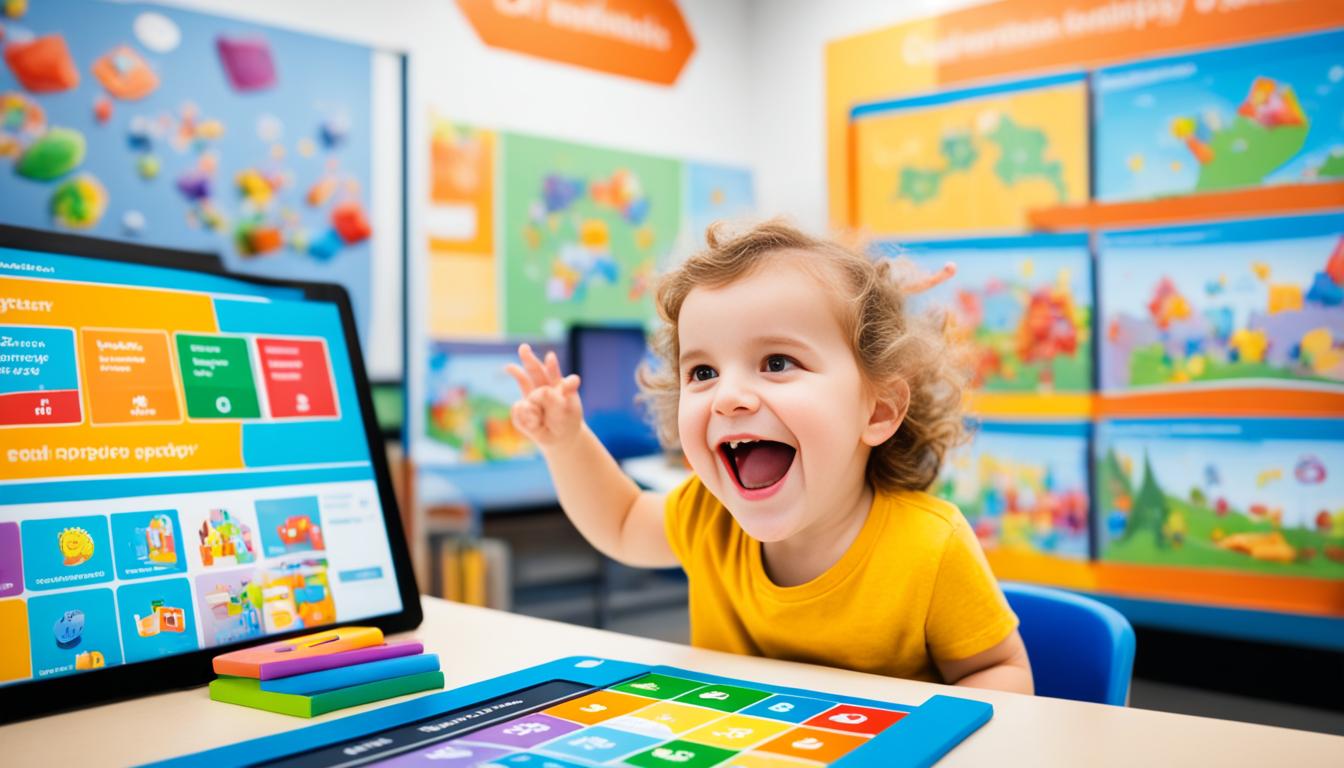Picture a classroom buzzing with enthusiastic voices, inquisitive minds, and energetic participation. Students are actively immersed in the subject matter, absorbing knowledge through hands-on experiences, and working together with their classmates. This exemplifies the impact of interactive learning resources for children. By integrating digital tools, educational games, and online activities, educators can establish a lively and captivating learning atmosphere that grabs and retains student interest.
Let’s step into the shoes of Sophia, a second-grade student who loves learning through interactive resources. As Sophia enters her classroom, she sees her teacher, Ms. Johnson, setting up a math activity on the interactive whiteboard. The activity involves solving addition problems using colorful manipulatives and drag-and-drop features. Sophia’s eyes light up with excitement as she can’t wait to participate in the engaging math game.1
Throughout the school day, Sophia and her classmates explore a variety of interactive learning resources. They visit the ABC Mouse website, where over 9,000 activities are available for children ages 2-7, covering subjects like reading, math, science, and art.1 They also enjoy playing educational games on CoolMath4Kids, which offers math games, lessons, quizzes, manipulatives, and brain teasers for children of all ages and skill levels.1 In science class, they watch captivating videos and dive into hands-on experiments on MysteryScience.com.1
During their reading time, Sophia and her classmates access Raz-Kids, where they can choose from hundreds of eBooks at 29 different reading levels.1 And when it’s time for art class, they follow step-by-step drawing videos on Art For Kids Hub, expanding their creativity and artistic skills.1
In addition to these resources, Sophia and her classmates explore informative news stories and videos on Time For Kids, engage in math and language arts games on Starfall and Fun Brain, and enjoy age-appropriate games and videos on Nick Jr.1
As the school day comes to an end, Sophia reflects on her interactive learning experiences. She realizes that these resources have made a significant impact on her education. Not only have they kept her engaged and excited about learning, but they have also fostered her critical thinking, problem-solving, and collaboration skills.2
Key Takeaways:
- Interactive learning resources offer engaging opportunities for students to actively participate and interact with the subject matter.
- They include educational games, online activities, and interactive tools that promote critical thinking and engagement in students.
- Platforms like ABC Mouse, CoolMath4Kids, Raz-Kids, MysteryScience.com, Art For Kids Hub, Time For Kids, Starfall, Fun Brain, Nick Jr., and Highlights for Kids provide a wide range of interactive learning resources for children of different ages and interests.1
- Interactive learning goes beyond increased student engagement; it also develops cooperation skills and enhances thinking and problem-solving abilities.2
What are Interactive Lessons?
Interactive lessons are a dynamic approach to learning that encourages students to actively engage with the subject matter and collaborate with their peers and teachers. In interactive lessons, students don’t passively absorb information; instead, they actively participate in discussions, work with classmates, and engage in hands-on learning experiences. This active involvement promotes collaborative learning and enhances student engagement and student engagement. Interactive lessons can be developed for both synchronous and asynchronous instruction and often leverage digital tools to increase student engagement.
Benefits of Interactive Lessons
Interactive lessons have numerous benefits for students. Firstly, they empower students to become better readers, writers, speakers, and thinkers by providing opportunities for them to actively participate in their learning. This hands-on approach allows students to gain a deeper understanding of the subject matter and fosters critical thinking skills.
Secondly, interactive lessons promote collaborative learning by encouraging students to work together and share ideas. Through discussions and group activities, students learn from one another and build their interpersonal skills. This collaborative aspect of interactive lessons not only enhances learning outcomes but also prepares students for real-world collaborative work environments.
Furthermore, interactive lessons provide opportunities for students to receive immediate feedback from their peers and teachers. This feedback loop is crucial for student growth and development. Foundations A-Z and Writing A-Z provide tips for effective feedback in interactive lessons3. When students receive timely and constructive feedback, they can make adjustments and improve their learning outcomes.
Engaging Students Through Interactive Learning
Interactive lessons offer various strategies to keep students engaged and motivated. One popular approach is integrating interactive games into the learning process. Interactive games in vocabulary instruction from Vocabulary A-Z engage students in learning3. These games provide a fun and interactive way for students to practice and reinforce their vocabulary skills while staying engaged and motivated.
Another effective method is incorporating instructional videos into the lessons. Instructional videos in Foundations A-Z enhance foundational reading skills through engaging mascots3. These videos not only capture students’ attention but also provide visual and auditory cues, making difficult concepts more accessible and memorable.
In addition, giving students the freedom to choose their learning style can boost their engagement and empower them to take an active role in their education4. By providing a variety of interactive activities and allowing students to choose based on their strengths and preferences, teachers can create a personalized learning experience that caters to each student’s needs.
Overall, interactive lessons create an engaging and active learning environment where students can explore, collaborate, and apply their knowledge. By incorporating interactive elements, teachers can facilitate meaningful learning experiences that foster critical thinking, collaboration, and student engagement.
Overcoming Challenges in Interactive Learning
While interactive learning has proven to be an effective way to engage students and promote active participation, it is not without its challenges. One of the main challenges is maintaining student engagement throughout the learning process, especially for students who may be hesitant to participate or initiate conversations with their peers.
According to John Dewey in 1938, children require high-quality experiential learning that is well designed for their needs and aptitudes to move away from the traditional lecture model towards a more hands-on education model.5
To overcome this challenge, it is crucial to incorporate interactive lessons that include specific roles and responsibilities for students. One effective approach is implementing literature circles, where students take on different roles and actively engage with the content.
“Interactive classrooms involve various forms of interactions, such as touching and manipulating objects, collaboratively creating products, performing experiments, and engaging in debates.”5
By providing clear expectations for students, teachers create a positive learning environment where students feel more confident and motivated to participate in discussions and activities.
Interactive learning techniques help students understand ideas more profoundly and remember them better than traditional methods.5
Clear expectations can include guidelines for active listening, respectful communication, and meaningful contributions. When students know what is expected of them, they are more likely to actively engage in the learning process and develop a sense of ownership over their education.
Interactive lesson plans are effective in engaging students in the classroom and ensuring active learning.5
Incorporating interactive learning resources, such as educational games and digital tools, can also help maintain student engagement. These resources provide interactive and dynamic experiences that capture students’ attention and foster their active participation throughout the learning process.
Different interactive activities align with different levels of Bloom’s Taxonomy, from remembering and understanding to creating.5
Additionally, incorporating technology, such as augmented reality and virtual reality, can enhance interactive learning by providing students with immersive experiences that make learning more engaging and memorable.
Technology such as augmented reality and virtual reality can enhance interactive learning by providing students with immersive experiences.5
Overall, by addressing the challenge of maintaining student engagement and incorporating interactive learning resources and clear expectations, teachers can create a vibrant and interactive learning environment that promotes active participation and deeper learning.

Leveraging Literature Circles for Engagement
In literature circles, students take on different roles, such as the discussion director, the vocabulary enricher, the summarizer, and the connector. Each role comes with specific responsibilities that encourage active participation and engagement in the text.
For example, the discussion director is responsible for generating discussion questions, leading the group in meaningful conversations, and facilitating deeper understanding of the text.
On the other hand, the vocabulary enricher focuses on identifying and exploring challenging vocabulary words, helping their peers expand their vocabulary and comprehension.
By implementing literature circles, teachers can create a structured and interactive learning environment that encourages both individual accountability and collaborative group work.
Techniques like mock trials and class discussions foster analyzing and evaluating skills in students within an interactive classroom setting.5
Through literature circles, students develop critical thinking skills, engage in meaningful conversations, and gain a deeper understanding of the texts they read.
| Benefits of Literature Circles in Interactive Learning | Reference |
|---|---|
| Encourages active participation | 5 |
| Promotes critical thinking skills | 5 |
| Enhances comprehension and analysis | 5 |
| Develops collaboration and communication skills | 5 |
By implementing strategies such as literature circles and providing clear expectations, teachers can overcome the challenge of maintaining student engagement and create a dynamic and interactive learning environment.
Creating Effective Interactive Lesson Plans
When it comes to creating interactive lesson plans, providing constructive feedback is essential for student growth and success. By offering thoughtful and actionable feedback, teachers can guide students towards improving their skills and achieving their learning goals3. Platforms like Foundations A-Z and Writing A-Z offer interactive lessons that provide valuable tips for planning and delivering corrective, in-the-moment feedback3. These lessons also incorporate the gradual release of responsibility, allowing students to collaborate, share ideas, and work with a partner to deepen their understanding and engagement3.
“Remember, interactive lesson plans are not just about content delivery, but also about creating an environment where students can actively participate and learn from each other.”
– John Smith, Education Specialist
Interactive lessons go beyond simple lectures and static assignments. They encourage student engagement by involving them in the learning process and fostering an interactive learning community3. By incorporating interactive elements, teachers can cater to different learning styles and capture students’ attention, making the lessons more enjoyable and impactful3. Whether it’s through discussions, group projects, or hands-on activities, interactive lesson plans create an environment that empowers students to take ownership of their learning.
Additionally, linking premade lessons in resources like Vocabulary A-Z with Raz-Plus texts can enhance student engagement and vocabulary development3. These resources provide a comprehensive approach to interactive learning that combines various strategies and content areas, ensuring a well-rounded educational experience for students.
Benefits of Interactive Lesson Plans
When teachers adopt interactive lesson plans, students are more likely to actively participate, develop critical-thinking skills, and retain information6. The benefits of interactive lessons include:
- Increased student engagement and motivation.
- Improved collaboration and communication skills.
- Enhanced critical thinking and problem-solving abilities.
- Deeper comprehension and retention of class material.
- Fostered creativity and curiosity.
By providing students with interactive learning experiences, educators are setting them up for success both academically and in their future endeavors. Empowering students through interactive lessons helps them become lifelong learners and critical thinkers who can actively contribute to society.
Example Interactive Lesson Plan
Let’s take a look at an example of an interactive lesson plan that incorporates the principles of effective interactive teaching:
| Objective | Activity | Materials |
|---|---|---|
| Developing reading comprehension skills | Think-Pair-Share: Students read a short passage individually, discuss it with a partner, and share their thoughts with the whole class. | – Short passage – Chart paper – Markers – Timer |
| Improving writing skills | Peer Editing: Students exchange their written essays, provide constructive feedback, and suggest improvements. | – Printed essays – Highlighters – Writing rubric – Peer editing checklist |
| Enhancing critical thinking | Role Play: Students take on different roles in a historical scenario, engage in a debate, and critically analyze multiple perspectives. | – Role play cards – Timer – Debate guidelines – Feedback forms |
Through this interactive lesson plan, students engage in various activities that promote collaboration, critical thinking, and effective communication. By incorporating different approaches in a single lesson, teachers can address multiple learning objectives and cater to diverse student needs6.
Remember, when designing interactive lesson plans, it’s important to make learning enjoyable, relevant, and responsive to students’ interests and abilities. By providing students with interactive and engaging learning experiences, teachers empower them to become active participants in their own education and set them on a path to lifelong learning and success.

Interactive Games for Learning
Interactive games can be a powerful tool for motivating and engaging students in the learning process. By combining game elements with educational objectives, these games provide an interactive and enjoyable way for students to enhance their knowledge and skills. One platform that offers a wide range of interactive games for learning is TurtleDiary.
TurtleDiary is a comprehensive website that offers over 1000 learning activities for grades K-5, making it a valuable resource for educators and parents alike. The website features various interactive games, including multiplayer, noun, pronoun, word, verb, adverb, and adjective games, allowing students to practice and reinforce their understanding of different concepts in a fun and engaging way7. The platform also offers quizzes for children from first to fifth grade, providing instant evaluations and reinforcing learned concepts.
In addition to the interactive games and quizzes, TurtleDiary provides educational games in subjects such as math, language, art, typing, science, and geography, offering a comprehensive learning experience across different disciplines7. These games cater to a wide range of learning preferences and can support vocabulary instruction, allowing students to expand their vocabulary and language skills.
With millions of plays, some of the top-rated games on TurtleDiary have garnered significant attention and engagement from students. Examples include the Multiplayer Basketball game with 1,936,715 plays, the Ninja Multiplayer game with 2,501,375 plays, and the Typing Race Multiplayer game with 3,361,351 plays7. It’s clear that these games have captivated and motivated students to participate in the learning process.
Furthermore, TurtleDiary offers typing lessons categorized into basic, intermediate, and advanced levels, helping children develop effective typing skills7. The platform also presents assessment tools such as a worksheet generator, printable lessons, assessment tests, assignments, reports, Google Drive integration, and Google Classroom integration, enabling teachers to track student activities and progress effectively7.

RoomRecess.com: Interactive Learning Games for Skill Development
Another platform that provides a wide range of interactive learning games is RoomRecess.com. This website offers learning games that cover various skills in math, reading, spelling, language arts, and problem-solving8. These games are designed to be engaging and effective, making learning a fun and interactive experience.
One of the key benefits of RoomRecess.com is that it offers free learning games without requiring students to sign up or hold an account to access the activities8. This accessibility makes it convenient for both teachers and students to utilize the platform and explore the interactive games.
Math learning games on RoomRecess.com focus on essential skills such as computation, geometry, fractions, decimals, place value, rounding, integers, and problem-solving8. These games provide a hands-on approach to learning math concepts, helping students build a solid foundation in mathematics.
Reading games offered by RoomRecess.com cover a wide range of strategies, including main idea, author’s purpose, cause and effect, fact and opinion, context clues, and drawing conclusions8. These games enhance reading comprehension and critical thinking skills, providing students with interactive opportunities to practice important literacy skills.
RoomRecess.com also offers word games that help kids learn grammar, spelling, sight words, and other word skills. The topics covered include parts of speech, prefixes and suffixes, word forming, ELA skills, grammar, and spelling8. By playing these word games, students can improve their language abilities while having fun.
In addition to subject-specific games, RoomRecess.com features classroom tools for teachers, including a random number generator, a classroom timer, a social studies game, and a trivia game spanning five subjects8. These tools can enhance the learning experience and provide interactive opportunities for students to engage with different subjects.
Enhancing Vocabulary Instruction with Interactive Games
Vocabulary instruction is a crucial component of language development, and interactive games can play a significant role in supporting vocabulary acquisition. Online platforms like Vocabulary A-Z offer assignable, digital game-based activities that integrate spelling lists with opportunities for students to practice and build their vocabulary, phonics, and spelling skills7. By incorporating interactive games into daily instruction, teachers can enhance students’ learning experiences and support their overall comprehension.
Interactive Games for Digital Learning
Interactive games are valuable digital learning tools that can engage students and foster active participation in their education. These games provide opportunities for students to apply and reinforce their learning in a playful and interactive way. By incorporating interactive games into instructional strategies, teachers can create a dynamic and engaging learning experience for their students.
| Platform | Features | Subject Coverage | Engagement |
|---|---|---|---|
| TurtleDiary | – Over 1000 learning activities – Various interactive games including multiplayer, noun, pronoun, word, verb, adverb, and adjective games – Quizzes for reinforcement and evaluation – Educational games in math, language, art, typing, science, and geography – Typing lessons and assessment tools |
All core subjects | Millions of plays |
| RoomRecess.com | – Wide range of interactive learning games – Free access without sign-up requirements – Math, reading, spelling, language arts, and problem-solving games – Word games for grammar, spelling, sight words, and other word skills – Classroom tools for teachers |
Math, reading, spelling, language arts, problem-solving | Engaging and interactive |
Engaging Students Anywhere with Interactive Learning
Interactive learning can happen anywhere, whether it’s in a traditional classroom or a virtual setting. Technology offers various resources to engage students, such as instructional videos that model and target specific foundational reading instruction.
Platforms like Foundations A-Z provide instructional videos with engaging mascots that talk to students, making reading feel more like fun. These videos can be accessed from any location with internet connectivity, allowing students to interact with the content at their convenience.

Incorporating instructional videos into instruction can create more interactive learning opportunities and captivate students’ attention.
When students see characters in instructional videos demonstrating key skills, they are more likely to engage and practice those skills themselves. This form of foundational reading instruction promotes active learning and helps students develop strong literacy skills (Link 13).
“The use of instructional videos is an effective strategy for providing foundational reading instruction to students. These videos serve as guides, giving students a visual representation of key reading skills and strategies.”
Enhancing Classroom Instruction with Interactive Videos
Integrating instructional videos into classroom instruction provides students with interactive learning experiences. Teachers can use these videos to deliver foundational reading instruction in an engaging and meaningful way.
- Teachers can use instructional videos to introduce new concepts and demonstrate specific reading strategies (Link 13).
- Students can watch these videos at their own pace, rewinding or pausing as needed to reinforce their understanding of the content.
- Instructional videos can provide visual and auditory cues, making complex concepts easier to comprehend.
- Teachers can also assign videos as independent practice, allowing students to review and reinforce their learning outside of the classroom.
| Benefits of Using Instructional Videos for Foundational Reading Instruction | Link |
|---|---|
| Engages students in the learning process | Link 13 |
| Improves retention and comprehension of key concepts | Link 13 |
| Offers flexibility for students to review content at their own pace | Link 13 |
By incorporating instructional videos into foundational reading instruction, teachers can create interactive learning opportunities that cater to the diverse needs of their students. These videos provide additional support, reinforce concepts, and foster a love for reading (Link 13).
Using Technology for Collaborative Workspaces
Technology plays a crucial role in creating collaborative workspaces where teachers and students can engage and interact in meaningful ways. By leveraging interactive technology and digital writing platforms like Writing A-Z, educators can foster a classroom community of writers and empower students in their literacy journey. These platforms allow teachers to model expectations, provide guided support, and work closely with students to improve their writing skills. With features like Writing and Learning Together (WaLT), students can access the same tools and materials as their teachers, completing writing activities, reviewing samples, and receiving valuable feedback to become independent and effective writers.

Interactive technology provides numerous benefits to both teachers and students in the classroom. By incorporating digital writing platforms like Writing A-Z, teachers can create a collaborative learning environment where students actively participate and engage with the subject matter. These platforms not only facilitate collaboration but also help in fostering classroom community and building a sense of belonging among students.
“Interactive technology offers teachers the opportunity to create a classroom community of writers where students can harness their creativity and become skilled in digital writing platforms.”
With digital writing platforms, teachers can model expectations and provide guided support throughout the writing process. Students can explore various writing genres, collaborate with peers, and receive real-time feedback, helping them refine their writing skills and develop a strong writing voice.9
The use of interactive technology, such as digital writing platforms, encourages individual and collective voices among students. By providing students with the tools and resources to express themselves, teachers empower them to share their thoughts, perspectives, and ideas with their peers and a global audience.10
Designing collaborative learning spaces involves involving students in the process from the beginning and making every space a space for learning. Digital writing platforms enable students to access their work from anywhere, facilitating flexible and personalized learning experiences. The seamless integration of technology into classroom furniture and lessons empowers students to create personalized paths to learning, making education more interactive and engaging.10
Flexible seating options in classrooms offer students choice and variability throughout the day. When combined with digital writing platforms, teachers can provide a dynamic and adaptable learning environment that meets the diverse needs of their students.10
Benefits of Using Digital Writing Platforms in Collaborative Workspaces
The use of digital writing platforms in collaborative workspaces offers several advantages:
- Enhanced Collaboration: Students can collaborate with their peers, providing feedback, sharing ideas, and working together to improve their writing skills. This fosters teamwork and develops important interpersonal skills.11
- Real-Time Feedback: Students receive immediate feedback from their teachers, enabling them to make revisions and improvements to their writing. This helps students grow as writers and develop self-reflection skills.9
- Global Audience: Digital writing platforms allow students to share their work with a larger audience, providing an authentic and meaningful context for their writing. Students can showcase their skills and perspectives to a global community of readers.10
- Organized Writing Process: Digital writing platforms provide students with structured templates and tools, guiding them through the writing process. This promotes organization and helps students develop effective writing habits.11
- Access to Resources: Digital writing platforms offer a wide range of resources, such as writing prompts, graphic organizers, and examples of high-quality writing. Students can access these resources to support their learning and improve their writing skills.11
By incorporating interactive technology and digital writing platforms, educators can create collaborative workspaces that foster creativity, encourage critical thinking, and empower students to become confident and skilled writers. These tools provide the foundation for a vibrant and engaging learning environment where students can thrive and achieve their full potential.
Incorporating Interactive Lesson Plans for Success
Interactive lesson plans have the ability to inspire curiosity and engagement in students. By incorporating interactive learning resources into your teaching, you can simplify the learning process and create a more exciting educational experience. Learning A-Z offers a wide variety of academic solutions that make learning more engaging and interactive for both students and teachers.
Whether you’re in a traditional classroom or a virtual setting, interactive lesson plans provide opportunities for students to actively participate in their education. These lesson plans are designed to promote critical thinking, collaboration, and active learning. By incorporating interactive activities and digital tools, you can create a dynamic learning environment that keeps students motivated and involved.
Learning A-Z offers a range of interactive learning resources that cater to different subjects and grade levels. From interactive worksheets and assessments to multimedia lessons and digital books, there are endless options to choose from. These resources not only simplify the learning process but also make it more engaging and enjoyable for students.
One example of an interactive learning resource is the use of educational games. Studies have shown that educational games in the classroom improve student engagement and interaction, enhancing social and problem-solving skills12. By incorporating gamified activities like quizzes or interactive games, you can create a fun and stimulating learning environment that keeps students actively involved in the lesson.
In addition to games, interactive lesson plans can also include activities such as role play or jigsaw activities, which promote collaboration and critical thinking. These activities involve student participation in problem-solving discussions or team tasks, allowing them to apply learned concepts to real-life situations and develop various skills like writing, leadership, coordination, collaboration, and research13. By incorporating such activities, you can foster a more interactive and collaborative learning experience for your students.
Another advantage of interactive lesson plans is the ability to track student progress through formative assessment tools. For example, using gamified platforms like Time to Climb allows teachers to assess student understanding in real-time and identify specific areas where students may need additional support12. This immediate feedback enables teachers to provide targeted instruction and address individual learning needs effectively.
Overall, incorporating interactive lesson plans and learning resources simplifies the learning process by providing opportunities for active participation, collaboration, and critical thinking. By leveraging the power of technology and interactive activities, you can create a dynamic and engaging learning environment that motivates students to explore, discover, and excel in their education.
Example of Interactive Lesson Plan Activities
Engaging students in interactive lesson plans can be achieved through a variety of activities. Here are a few examples:
- Entry & Exit Tickets: Collect feedback and assess student understanding using various formats such as 3”x5” cards, small pieces of paper, or online surveys13.
- Writing Activities: Incorporate Free Writing, Minute Paper, or Question of the Day exercises to encourage critical thinking and reflection. These activities usually last around 1-2 minutes13.
- Ice Breakers: Use low-stakes activities at the beginning of the semester to encourage student interaction and communication. This helps create a positive and inclusive classroom environment13.
- Think-Pair-Share: Engage students in individual and group activities by allowing them to work individually, then in pairs, and finally share their ideas with the whole class. This activity encourages critical thinking and collaboration13.
- Case Studies: Present real-life scenarios that require students to apply learned concepts and engage in problem-solving discussions. This promotes critical thinking and analysis13.
| Activity | Description |
|---|---|
| Interview or Role Play | Motivate students to solve problems and develop various skills such as writing, leadership, coordination, collaboration, and research13. |
| Jigsaw Activities | Divide students into teams to solve problems or analyze readings, then bring all ideas together for a comprehensive solution. This promotes teamwork and critical thinking13. |

Remember, incorporating interactive lesson plans and learning resources not only simplifies the learning process but also creates a more engaging and dynamic classroom environment. By leveraging the power of technology and interactive activities, you can inspire curiosity, foster collaboration, and ultimately enhance student learning experiences.
Conclusion
Interactive learning resources play a crucial role in keeping students engaged and excited about learning. By incorporating digital tools, interactive lessons, and engaging activities, teachers can create a collaborative learning environment that promotes critical thinking, collaboration, and student engagement. Whether in a traditional classroom or a virtual setting, interactive learning resources provide opportunities for students to actively participate and interact with the subject matter, making education more exciting and impactful.
Research has shown that interactive teaching methods, such as think-pair-share, brainstorming, and buzz sessions, are effective in engaging students and enhancing their participation and knowledge retention6. Interactive activities, such as exit slips, misconception checks, and circle the questions, not only assess student understanding but also promote personalized learning6. Pair activities encourage collaboration and critical thinking, while group activities foster teamwork and discussion in the classroom6. Engaging tools like interactive games, such as crossword puzzles, scrabble, and bingo, reinforce learning and make the educational experience enjoyable for students6.
Additionally, utilizing e-learning and interactive learning can quicken the educational process, resulting in students mastering skills faster and saving time4. Interactive learning also saves money by eliminating the need for physical space and resources, making education more cost-effective and accessible4. It enables teachers to track student progress easily and offers flexibility in lesson planning, adjustments, and collaboration opportunities4. Giving students the freedom to choose their learning styles empowers them, encourages active participation, and enhances learning efficiency through student-to-student collaboration4. The flexibility and hands-on approach of interactive learning allow teachers to assess student understanding at each step of the learning process4.
FAQ
What are interactive learning resources for kids?
How can interactive lessons benefit students?
How can teachers overcome challenges in maintaining student engagement?
How can teachers create effective interactive lesson plans?
How can interactive games enhance student learning?
Can interactive learning happen in a virtual setting?
How can technology promote collaboration in the classroom?
How can interactive lesson plans simplify the learning process?
How do interactive learning resources support engagement in virtual learning?
Source Links
- https://www.mkewithkids.com/post/10-educational-websites-that-will-actually-let-you-work-for-an-hour-or-two/
- https://www.teachhub.com/professional-development/2021/05/using-interactive-learning-to-improve-student-engagement/
- https://www.learninga-z.com/site/resources/breakroom-blog/engaging-students-with-interactive-learning
- https://mussila.com/the-top-6-benefits-of-interactive-learning/
- https://www.classvr.com/blog/a-teachers-guide-to-interactive-classrooms/
- https://www.bookwidgets.com/blog/2018/06/20-interactive-teaching-activities-for-in-the-interactive-classroom
- https://www.turtlediary.com/
- https://www.roomrecess.com/
- https://shakeuplearning.com/blog/15-collaborative-tools-for-your-classroom-that-are-not-google/
- https://www.edutopia.org/blog/collaborative-learning-spaces-connect-to-world-jennifer-williams-fran-siracusa
- https://www.weareteachers.com/student-collaboration-tech-tools/
- https://nearpod.com/blog/educational-games-time-to-climb/
- https://www.brown.edu/sheridan/teaching-learning-resources/teaching-resources/classroom-practices/active-learning/interactive










